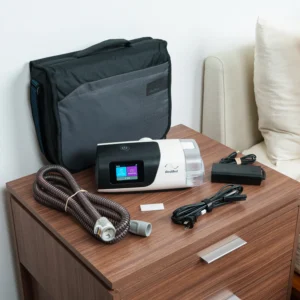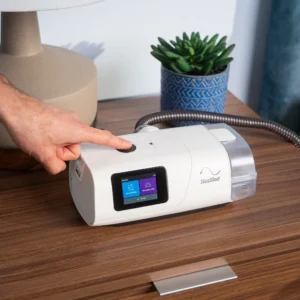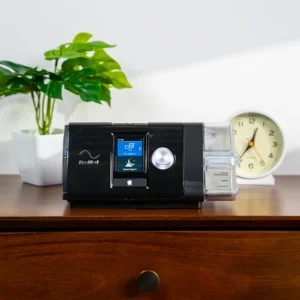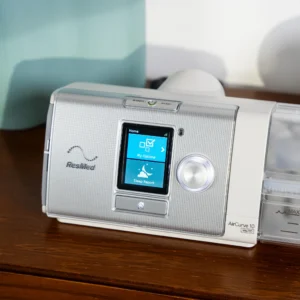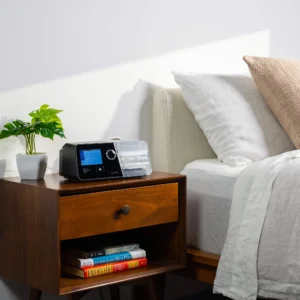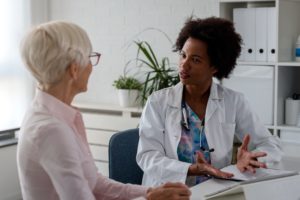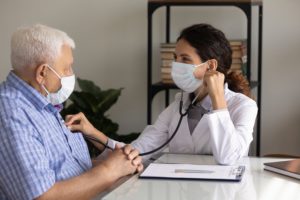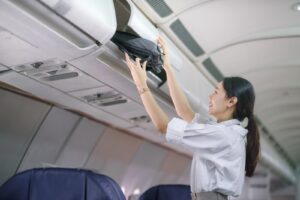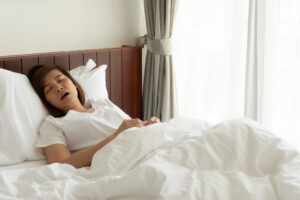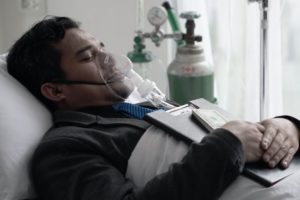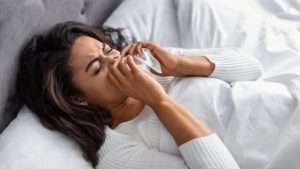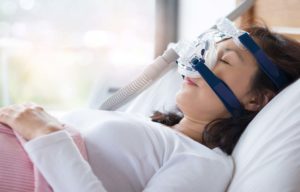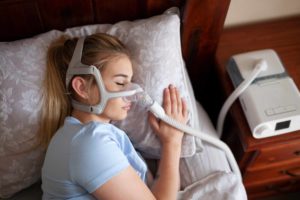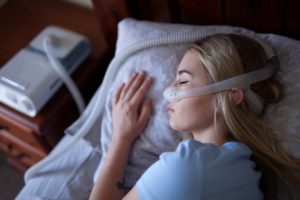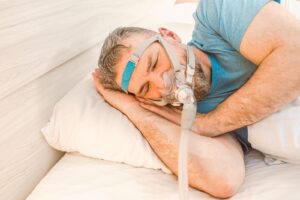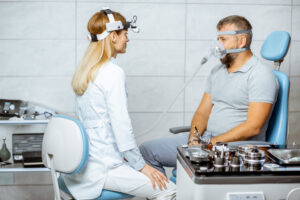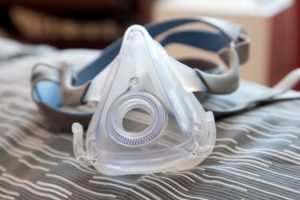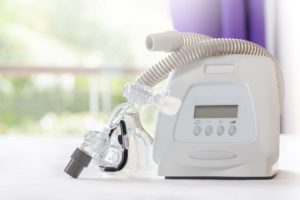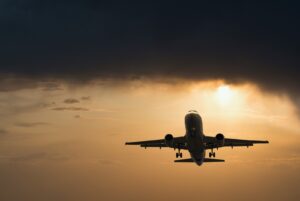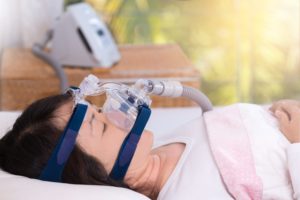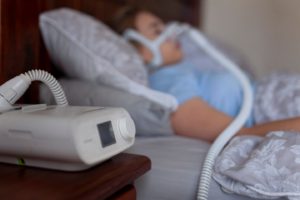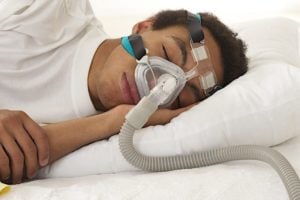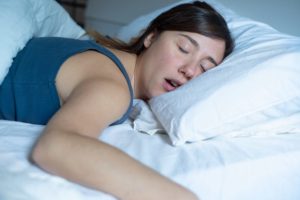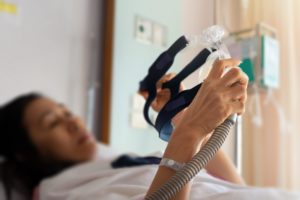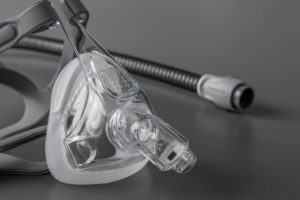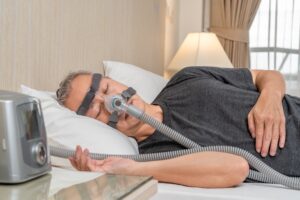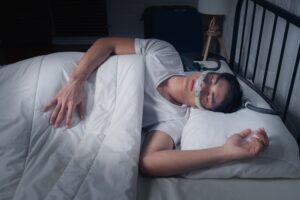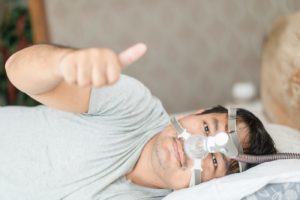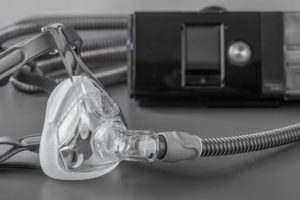When you buy through our links, we may earn a commission. Products or services may be offered by an affiliated entity. Learn more.
How to Use a CPAP Machine
- Proper setup and mask fitting are essential for effective CPAP therapy; starting with the right mask type and fit helps reduce leaks and discomfort.
- Learning nightly routines and comfort features—such as using the ramp function and adjusting humidification—can make it easier to fall asleep and stay comfortable with CPAP.
- Consistent use and good maintenance (cleaning the mask, hose, and humidifier regularly) improve therapy effectiveness and prolong equipment life.
Starting CPAP therapy can feel overwhelming at first, but with the right setup and routine, it often becomes much easier. CPAP machines are designed to treat obstructive sleep apnea (OSA) by delivering a steady stream of air that keeps the airway open during sleep, helping reduce symptoms like snoring, breathing pauses, and daytime sleepiness.
While it may take time to adjust to wearing a mask and sleeping with pressurized air, many people find that consistent use leads to better sleep quality and improved overall health. Below, we’ll walk through step-by-step instructions and practical tips to help you get started with CPAP therapy and build habits that support long-term success.

Exploring CPAP Machines — But Haven’t Been Tested Yet?
Start with our easy, at-home sleep test. It’s stress-free and effective. Get results within a few days.
How to Set Up Your CPAP Machine
If you’ve been given a prescription for a CPAP machine, it’s normal to have questions about how to set it up and use it in the right way. The process is straightforward and follows a series of steps.
Make Note of the Parts
When you first open your CPAP, write down the brand, model, and serial number. Keep that information with the owner’s manual. In the same place, jot down the phone number for your sleep technician, the CPAP manufacturer, and, if applicable, the local service provider who delivered your machine. These steps will simplify the process if you have any technical problems in the future.
Find a Good Space to Put the CPAP Machine
A first step is deciding where you’re going to put the CPAP. A good space for your device meets these characteristics:
- Provides stable support to the base of the CPAP
- Allows the hose to reach the head of the bed
- Close enough to an outlet so that you can easily plug in the machine
- Permits unobstructed ability to turn on the device, open the filter compartment, and add water to the humidifier
For most people, the optimal spot is on a nightstand or small table next to their bed.
Check the Filter
The CPAP machine comes with a replaceable filter, but the exact type of filter depends on your device. There’s usually a small compartment in which the filter fits snugly. Written instructions or instructions from your sleep technician should provide specific details about the filter in your CPAP machine.
Attach the Hose to the Machine and Mask
The machine has a special connector for the hose. The hose should attach and stay in place without exerting considerable force or effort. The other end of the hose plugs into the CPAP mask and should create a tight connection, sometimes by clicking into place.
Set Up the Humidifier (When Applicable)
Many CPAP machines have an attached humidifier to moisturize the air so that it’s less likely to dry out your mouth and throat over the course of the night.
If your CPAP has a humidifier, fill it with distilled water only. Using distilled water prevents mineral buildup or any impurity issues that can come from using tap water. The humidifier reservoir should have a clear “MAX” fill line. Be careful not to exceed that level, which can cause water to enter the hose.
How to Put on Your CPAP Mask
There are several types of masks that can be used with a CPAP. Your doctor or sleep specialist will recommend a mask based on several factors including how you breathe, the pressure you need, and your sleeping position. The three most common types of CPAP masks include:
- Nasal mask: Covers the nose only and delivers air through the nostrils
- Nasal pillow mask: Uses small, soft cushions that sit just inside the nostrils
- Full-face mask: Covers both the nose and mouth to deliver airflow
Regardless of the type of mask you use, it will be held in place using one or more straps that go around the top and/or back of your head.
To put on your CPAP mask, start by positioning the mask on your face, and then attach or pull the straps to secure it. The mask should form a seal against your face, but it should not pinch or press deeply into your skin. Adjust the length of the straps to find a comfortable fit.
How to Use Your CPAP Machine
Now that everything is set up correctly, you’re ready to start CPAP therapy.
Plug in the CPAP
Make sure that the power cord is properly attached to the CPAP device, then plug the device into an electrical outlet.
Turn on Your CPAP Machine
Once you have the mask in place, you can turn on your CPAP machine. The pressure settings will have already been set by your healthcare team, so you should be able to plug-and-play.
When the machine is on, you will notice pressurized air coming through the mask. If you hear air escaping from the mask, it’s a sign that you need to adjust it for a tighter seal. Some CPAP machines have a function to test whether the mask has a good seal.
When the device is turned on, you can decide whether to use the ramp function. This starts with lower pressure that gradually increases before reaching your prescribed pressure for the night. Some people like to ease into their sleep with the ramp function while others like to have full pressure from the start.
Find a Comfortable Sleeping Position
Test out a few sleeping positions to find those that are comfortable for your body, don’t interfere with your ability to wear the mask, and don’t pinch or block the hose.
Use Every Night
Using your CPAP machine every night—even during naps—is key to getting the full benefits of therapy. Sleep apnea symptoms can return as soon as you stop using CPAP, and inconsistent use may prevent your body from fully adjusting to treatment. Establishing CPAP as part of your nightly routine helps improve comfort, supports long-term adherence, and ensures your therapy remains effective over time.
How to Clean Your CPAP Machine
In order to keep your CPAP working in top shape, you’ll want to keep your mask, hose, and humidifier clean. Establishing a routine for frequent cleaning allows you to avoid buildup of dirt, bacteria, or other contaminants.
Daily Cleaning
Wash your mask cushion, humidifier water chamber, and any detachable mask components with warm water and mild soap. Rinse thoroughly and allow them to air-dry completely before use. Empty and refill the humidifier chamber daily using distilled water to reduce mineral buildup.
Weekly Cleaning
Soak the CPAP tubing, headgear, and reusable filters in warm, soapy water, rinse well, and hang the tubing to dry so moisture can fully drain. Check the manufacturer’s instructions for any parts that should not be submerged.
Cleaning Tips
- Avoid using harsh chemicals, bleach, or alcohol-based cleaners, as these can damage CPAP components and leave harmful residues.
- While automated CPAP cleaning devices are marketed for convenience, they aren’t recommended by many manufacturers, medical organizations, or the U.S. Food and Drug Administration (FDA).
- Replace disposable filters as recommended, usually every one to three months, or sooner if they appear dirty.
- When in doubt, follow the cleaning instructions provided with your specific CPAP machine and mask.
How to Get Used to Your CPAP Machine
Even with the best cpap machine, most people find it difficult to get started. The mask may be uncomfortable, the sensation of the pressurized air can be unsettling, and on some machines, noise from the device can be bothersome.
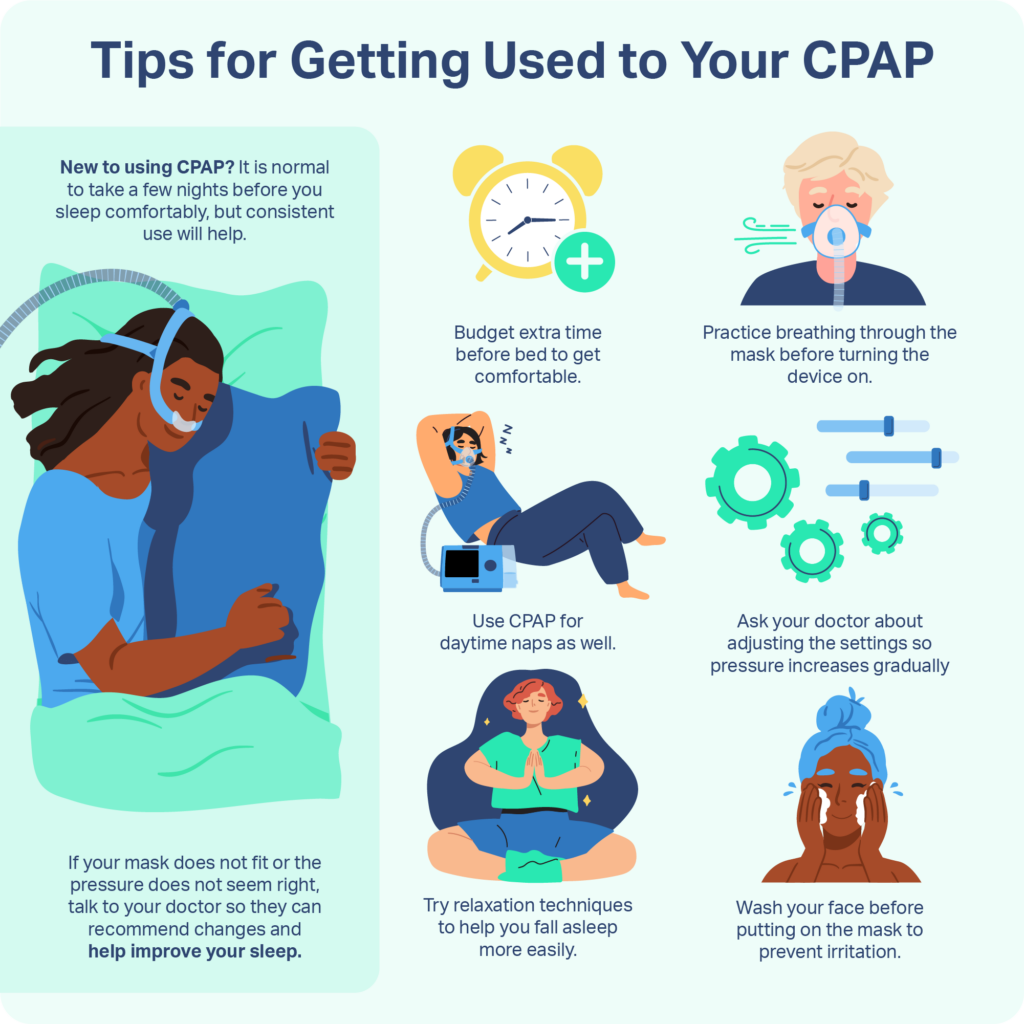
It’s normal for there to be an adjustment period before you are accustomed to and sleeping comfortably while using a CPAP. Several tips can help you get used to your CPAP.
- Expect it to take at least a few nights to adjust. Don’t give up or despair if you find the mask annoying or bothersome. You may even have a hard time sleeping at first, but you’ll get used to the CPAP faster by sticking with it. Over time, your sleep should improve.
- Budget extra time to get set up before bed. As you’re getting started with the CPAP device, it’s helpful to allot a bit of extra time before bed to fill the humidifier, get the mask on correctly, and position yourself comfortably.
- Practice wearing the mask and breathing with it on. To help get used to the mask, you can wear it without turning the machine on and practice breathing without any air coming through.
- Use the CPAP anytime you sleep. Most people think mostly about nighttime, but it’s best to wear the CPAP for any daytime naps as well.
- Consider using the Ramp function. If you’re having a hard time falling asleep because of the pressure, try using the Ramp function to have it kick in more gradually.
- Utilize relaxation exercises. Some people get anxious or claustrophobic when wearing a CPAP mask, and relaxation techniques can help put your mind at ease. Many of these steps for relaxation also help to fall asleep more easily.
- Wash your face before putting on the mask. Keeping your face clean can help create a good seal and reduce the potential for irritation during the night.
Another part of getting used to the CPAP is remembering to communicate with your doctor or sleep technician. If your mask isn’t comfortable, there is often another option to try that has a different size, shape, or type of cushioning. Similarly, if the pressure doesn’t seem right, your healthcare team can determine whether any adjustments are needed.
How to Troubleshoot Common CPAP Problems
While a CPAP device dramatically improves sleep in most people with sleep apnea, there can be uncomfortable side effects. . In most cases, these issues arise primarily in the first few nights, but some may persist over time. Common side effects—and potential solutions—include:
- Dry mouth: Using a heated humidifier or increasing your humidification setting can help prevent dryness. If you breathe through your mouth, switching to a full-face mask or adding a chin strap may also help.
- Nosebleeds: Nosebleeds are often caused by dry nasal passages, so increasing humidification or using a saline nasal spray before bed can help keep tissues moist.
- Nasal congestion: Heated humidification, nasal saline rinses, or allergy treatment may reduce nasal congestion.
- Runny nose: A runny nose can be triggered by cold or dry air, so adjusting humidifier temperature or switching to heated tubing may improve comfort.
- Coughing or respiratory infections: Regularly cleaning your CPAP mask, tubing, and humidifier chamber helps prevent the buildup of bacteria and mold that can contribute to infections.
- Skin irritation from the mask or straps: Ensuring proper mask fit, cleaning the mask daily, and using mask liners or strap covers can reduce friction and pressure on the skin.
- Chest discomfort: Mild chest discomfort may occur when first starting CPAP as your body adjusts to positive airway pressure. If discomfort continues, talk to your healthcare provider, as pressure settings or comfort features like pressure relief may need adjustment.
If you experience these issues, contact your doctor or sleep technician. Changes in settings or other steps can usually resolve these side effects of CPAP therapy and make it easier for you to sleep well while using the device.
When to Talk to Your Doctor
It’s normal to experience some adjustment issues when starting CPAP therapy, but ongoing or worsening symptoms shouldn’t be ignored. If side effects like discomfort, persistent dryness, congestion, mask leaks, or trouble tolerating pressure don’t improve with basic troubleshooting, it’s a good idea to contact your doctor or sleep specialist.
You should also reach out if you continue to snore, feel excessively sleepy during the day, or notice new symptoms such as chest pain, frequent headaches, or dizziness. Your provider can review your CPAP data, check mask fit and pressure settings, and recommend adjustments or alternative treatment options to help ensure your therapy is both comfortable and effective.
Frequently Asked Questions
Can I travel with my CPAP machine?
Yes, you can travel with a CPAP machine, and many models (like travel CPAP machines) are designed to be portable. CPAP machines are considered medical devices, so they don’t count toward carry-on limits when flying. If you’re traveling by air, it’s a good idea to bring your CPAP in your carry-on bag, check airline power requirements if you plan to use it onboard, and pack necessary accessories such as adapters or a battery if electricity may be unavailable.
What pressure should my CPAP be set at?
Your CPAP pressure should be set to the level prescribed by your healthcare provider based on the results of a sleep study or therapy data. Most CPAP machines operate within a range of 4 to 20 cm H2O, with many people needing pressures between 8 and 10 cm H2O, though the ideal setting varies by individual. You should not change your pressure settings on your own without consulting a sleep specialist.
Can I use purified water with my CPAP humidifier?
Purified water can be used in a CPAP humidifier if distilled water is unavailable, but it may contain minerals that can lead to residue buildup over time. Distilled water is recommended because it’s free of minerals and helps prevent scaling inside the humidifier chamber. If you use purified water occasionally, be sure to clean the water chamber regularly to avoid mineral deposits.

Still have questions? Ask our community!
Join our Sleep Care Community — a trusted hub of product specialists, sleep health professionals, and people just like you. Whether you’re searching for the perfect mattress or need expert sleep advice, we’ve got you covered. Get personalized guidance from the experts who know sleep best.
References
1 Sources
-
A.D.A.M. Medical Encyclopedia. (2020, January 29). Positive airway pressure treatment. MedlinePlus.
https://medlineplus.gov/ency/article/001916.htm


